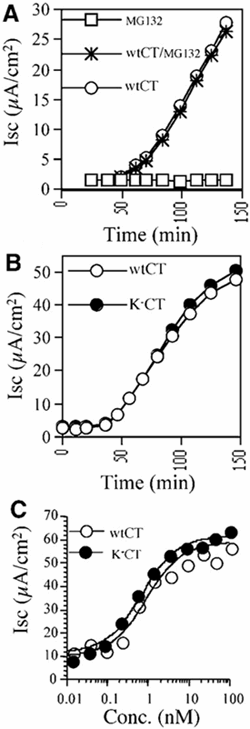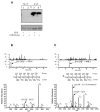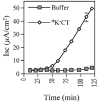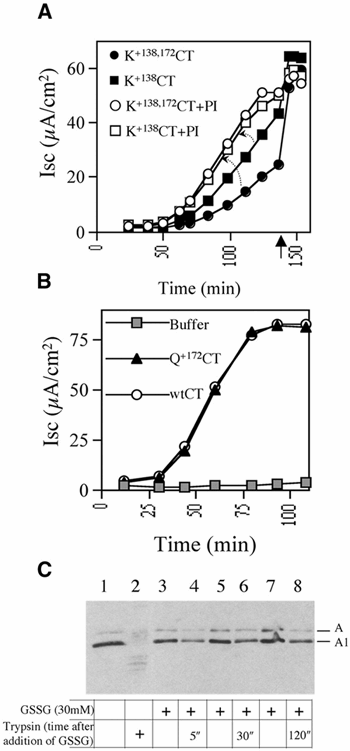Role of ubiquitination in retro-translocation of cholera toxin and escape of cytosolic degradation
- PMID: 12446567
- PMCID: PMC1308323
- DOI: 10.1093/embo-reports/kvf239
Role of ubiquitination in retro-translocation of cholera toxin and escape of cytosolic degradation
Abstract
Cholera toxin travels from the cell surface of affected mammalian cells to the endoplasmic reticulum (ER), where the A1 chain is released and retro-translocated across the ER membrane into the cytosol. We have tested whether, as in other cases, retro-translocation requires poly-ubiquitination. We show that an A1 chain mutant that lacks lysines and has a blocked N-terminus, and therefore cannot be ubiquitinated, remains active in vivo. The A1 chain is not degraded in the cytosol, as demonstrated by the fact that proteasome inhibitors do not stimulate its activity. When additional lysines are introduced into the A1 chain, moderate degradation by the proteasome is observed. The unfolded A1 chain rapidly refolds in vitro. These results show that poly-ubiquitination is not required for retro-translocation of all proteins across the ER membrane and indicate that the reason why the toxin escapes degradation in the cytosol may be both its paucity of lysines and its rapid refolding.
Figures




Similar articles
-
N-terminal extension of the cholera toxin A1-chain causes rapid degradation after retrotranslocation from endoplasmic reticulum to cytosol.J Biol Chem. 2010 Feb 26;285(9):6145-52. doi: 10.1074/jbc.M109.062067. Epub 2010 Jan 7. J Biol Chem. 2010. PMID: 20056601 Free PMC article.
-
Cholera toxin: an intracellular journey into the cytosol by way of the endoplasmic reticulum.Toxins (Basel). 2010 Mar;2(3):310-25. doi: 10.3390/toxins2030310. Epub 2010 Mar 5. Toxins (Basel). 2010. PMID: 22069586 Free PMC article. Review.
-
Establishment of an in vitro transport assay that reveals mechanistic differences in cytosolic events controlling cholera toxin and T-cell receptor α retro-translocation.PLoS One. 2013 Oct 11;8(10):e75801. doi: 10.1371/journal.pone.0075801. eCollection 2013. PLoS One. 2013. PMID: 24146777 Free PMC article.
-
A deubiquitinase negatively regulates retro-translocation of nonubiquitinated substrates.Mol Biol Cell. 2013 Nov;24(22):3545-56. doi: 10.1091/mbc.E13-06-0332. Epub 2013 Sep 25. Mol Biol Cell. 2013. PMID: 24068323 Free PMC article.
-
The intracellular voyage of cholera toxin: going retro.Trends Biochem Sci. 2003 Dec;28(12):639-45. doi: 10.1016/j.tibs.2003.10.002. Trends Biochem Sci. 2003. PMID: 14659695 Review.
Cited by
-
Endoplasmic reticulum-dependent redox reactions control endoplasmic reticulum-associated degradation and pathogen entry.Antioxid Redox Signal. 2012 Apr 15;16(8):809-18. doi: 10.1089/ars.2011.4425. Epub 2012 Jan 30. Antioxid Redox Signal. 2012. PMID: 22142231 Free PMC article. Review.
-
Insights on the trafficking and retro-translocation of glycosphingolipid-binding bacterial toxins.Front Cell Infect Microbiol. 2012 Apr 11;2:51. doi: 10.3389/fcimb.2012.00051. eCollection 2012. Front Cell Infect Microbiol. 2012. PMID: 22919642 Free PMC article. Review.
-
The E3 ubiquitin ligases Hrd1 and gp78 bind to and promote cholera toxin retro-translocation.Mol Biol Cell. 2010 Jan 1;21(1):140-51. doi: 10.1091/mbc.e09-07-0586. Epub 2009 Oct 28. Mol Biol Cell. 2010. PMID: 19864457 Free PMC article.
-
Proline Isomerization as a Key Determinant for Hsp90-Toxin Interactions.Front Cell Infect Microbiol. 2021 Oct 22;11:771653. doi: 10.3389/fcimb.2021.771653. eCollection 2021. Front Cell Infect Microbiol. 2021. PMID: 34746036 Free PMC article.
-
A binding motif for Hsp90 in the A chains of ADP-ribosylating toxins that move from the endoplasmic reticulum to the cytosol.Cell Microbiol. 2019 Oct;21(10):e13074. doi: 10.1111/cmi.13074. Epub 2019 Jul 5. Cell Microbiol. 2019. PMID: 31231933 Free PMC article.
References
-
- Deeks E.D., Cook J.P., Day P.J., Smith D.C., Roberts L.M. and Lord J.M. (2002) The low lysine content of ricin A chain reduces the risk of proteolytic degradation after translocation from the endoplasmic reticulum to the cytosol. Biochemistry, 41, 3405–3413. - PubMed
-
- Hazes B. and Read R.J. (1997) Accumulating evidence suggests that several AB-toxins subvert the endoplasmic reticulum-associated protein degradation pathway to enter target cells. Biochemistry, 36, 11051–11054. - PubMed
-
- Hershko A. and Ciechanover A. (1998) The ubiquitin system. Annu. Rev. Biochem., 67, 425–479. - PubMed
Publication types
MeSH terms
Substances
Grants and funding
LinkOut - more resources
Full Text Sources
Other Literature Sources

